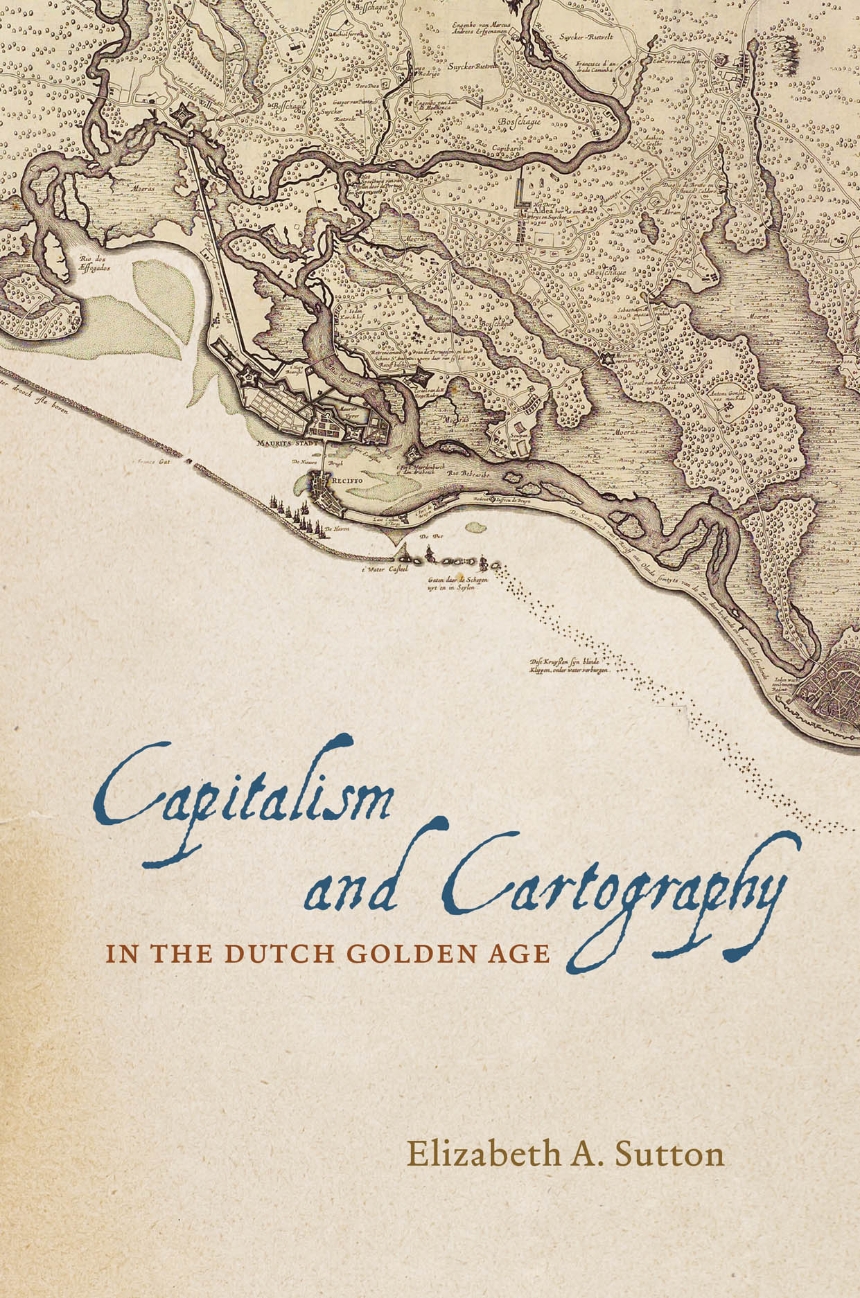Capitalism and Cartography in the Dutch Golden Age
In Capitalism and Cartography in the Dutch Golden Age, Elizabeth A. Sutton explores the fascinating but previously neglected history of corporate cartography during the Dutch Golden Age, from ca. 1600 to 1650. She examines how maps were used as propaganda tools for the Dutch West India Company in order to encourage the commodification of land and an overall capitalist agenda.
Building her exploration around the central figure of Claes Jansz Vischer, an Amsterdam-based publisher closely tied to the Dutch West India Company, Sutton shows how printed maps of Dutch Atlantic territories helped rationalize the Dutch Republic’s global expansion. Maps of land reclamation projects in the Netherlands, as well as the Dutch territories of New Netherland (now New York) and New Holland (Dutch Brazil), reveal how print media were used both to increase investment and to project a common narrative of national unity. Maps of this era showed those boundaries, commodities, and topographical details that publishers and the Dutch West India Company merchants and governing Dutch elite deemed significant to their agenda. In the process, Sutton argues, they perpetuated and promoted modern state capitalism.
Building her exploration around the central figure of Claes Jansz Vischer, an Amsterdam-based publisher closely tied to the Dutch West India Company, Sutton shows how printed maps of Dutch Atlantic territories helped rationalize the Dutch Republic’s global expansion. Maps of land reclamation projects in the Netherlands, as well as the Dutch territories of New Netherland (now New York) and New Holland (Dutch Brazil), reveal how print media were used both to increase investment and to project a common narrative of national unity. Maps of this era showed those boundaries, commodities, and topographical details that publishers and the Dutch West India Company merchants and governing Dutch elite deemed significant to their agenda. In the process, Sutton argues, they perpetuated and promoted modern state capitalism.
208 pages | 27 halftones | 6 x 9 | © 2015
Art: European Art
Geography: Cartography
History: Discoveries and Exploration, European History
Reviews
Table of Contents
Chapter 1. Capitalism, Cartography, and Culture
Early Modern Capitalism and Cartography
Theorizing Capitalist Cartography
Chapter Outlines
Chapter 2. Amsterdam Society and Maps
The Market for Maps
Organization of Government and the WIC
Pictorial and Intellectual Foundations
Social Organization and Hierarchy
Conclusion
Chapter 3. Capitalism and Cartography in Amsterdam
The Virtuous Merchant and the Republic
Visscher and the Amsterdam Map Tradition
The Beemster
The Grid, Private Property, and the Commonwealth
Chapter 4. Profit and Possession in Brazil
Visscher’s WIC-Authorized Map of Pernambuco
Johan Maurits and the Development of Recife and Mauritsstad
Blaeu and Barlaeus’s Representation of Brazil
Possession According to Grotius
Natural Rights, Sugar, and Human Exploitation
Trying Times: 1648
Chapter 5. Marketing New Amsterdam
Picturing New Amsterdam
WIC Colonial Policies 1629-49: Possession, Boundaries, Patroons, and Natives
The 1649 Affair
New Amsterdam Renewed
Conclusion
Chapter 6. Capitalism and Cartography Revisited
Acknowledgments
Bibliography
Index
Early Modern Capitalism and Cartography
Theorizing Capitalist Cartography
Chapter Outlines
Chapter 2. Amsterdam Society and Maps
The Market for Maps
Organization of Government and the WIC
Pictorial and Intellectual Foundations
Social Organization and Hierarchy
Conclusion
Chapter 3. Capitalism and Cartography in Amsterdam
The Virtuous Merchant and the Republic
Visscher and the Amsterdam Map Tradition
The Beemster
The Grid, Private Property, and the Commonwealth
Chapter 4. Profit and Possession in Brazil
Visscher’s WIC-Authorized Map of Pernambuco
Johan Maurits and the Development of Recife and Mauritsstad
Blaeu and Barlaeus’s Representation of Brazil
Possession According to Grotius
Natural Rights, Sugar, and Human Exploitation
Trying Times: 1648
Chapter 5. Marketing New Amsterdam
Picturing New Amsterdam
WIC Colonial Policies 1629-49: Possession, Boundaries, Patroons, and Natives
The 1649 Affair
New Amsterdam Renewed
Conclusion
Chapter 6. Capitalism and Cartography Revisited
Acknowledgments
Bibliography
Index
